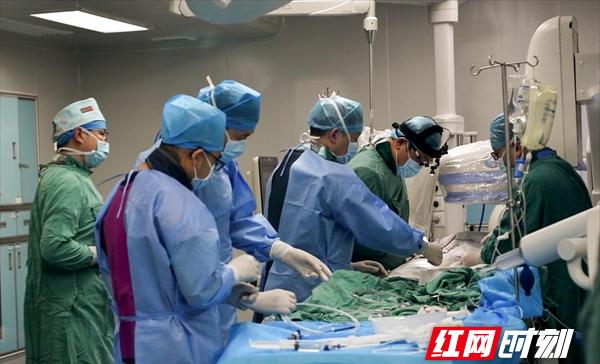Red net moment December 13 news (correspondent He Honghua Li Yijun) "valves arrived smoothly, paced 160, release valves ..." December 12 at 12:00 a.m., Chenzhou First People's Hospital's first transcatheter aortic valve replacement (TRVA) is being carried out nervously in the cardiology operating room, with the smooth release of artificial heart valves in the patient's body, everyone breathes a long sigh of relief, as if magic, in the absence of chest opening, the doctor successfully inserted an artificial heart valve into the patient's body, Replaced the aortic valve, which was already severely narrowed.

At 12:00 a.m. on December 12, the First People's Hospital of Chenzhou City underwent the first transcatheter aortic valve replacement (TRVA).
Patient Li Lao has been 68 years old, in the past three months, he often felt chest tightness and shortness of breath during activities, and also fainted twice, the children quickly took him to the First People's Hospital of Chenzhou City for treatment, through the heart ultrasound to clarify the condition: the aortic valve is severely calcified and severely narrowed!
According to the traditional treatment plan, Li Lao needs to open his chest for aortic valve replacement, but the patient is old and his physical condition is not too good, and it is difficult to tolerate such a major operation. Wang Zhonghua, director of the Department of Cardiology, and Li Yijun, chief physician of cardiothoracic surgery, after in-depth discussion, believe that transcatheter aortic valve replacement is the most appropriate treatment plan at present.
Transcatheter aortic valve replacement is a minimally invasive valve replacement procedure in which the artificial heart valve is transported through the arterial blood vessel to the aortic valve position through interventional catheterization without opening the chest, so as to complete the implantation of the artificial valve and restore the function of the valve. However, TAVR surgery involves many disciplines, the requirements for hospital hardware and personnel are extremely high, there is no precedent for successful development in Chenzhou City, do we have the conditions to carry out TAVR surgery? This became a question mark hanging in the hearts of Wang Zhonghua and Li Yijun.
Multidisciplinary preoperative discussion.
After obtaining the support of the hospital leaders, the First People's Hospital of Chenzhou City quickly formed an MDT team, including eight disciplines including cardiovascular medicine, cardiothoracic surgery, interventional medicine, anesthesia, color ultrasound room, CT room, operating room, and extracorporeal circulation group. Through self-review and careful comparison, the members unanimously concluded that the conditions are ripe and TAVR surgery can be done! After full communication with patients and their families, and also gaining their trust, the preparations for the operation began to be carried out intensively.
After a week of preparation, the operation was carried out as scheduled on the morning of December 12, and the departments performed their duties and cooperated closely according to the pre-formulated surgical plan, and after more than two hours of intense surgery, a biological valve was successfully implanted into the patient. Intraoperative esophageal ultrasound and contrast showed that the new valve was released perfectly, the valve opening and closing performed well, there was no perivalvular leakage, and the patient was expected to be discharged after three days.
The domestic TAVR market started late, since 2010 academician Ge Junbo and others implemented the first case of TAVR surgery, the technology was gradually promoted and used in China, and in 2015 published the "Transcatheter Aortic Valve Replacement Chinese Expert Consensus". As of 2020, the cumulative number of domestic TAVR implants has exceeded 5,000. At present, the patients targeted by TAVR in China are mainly concentrated in the elderly patients with severe aortic stenosis (SAS) who are at high risk of surgery or who are unable to perform surgery, and the relevant data estimate that there were about 1.435 million patients of this type in 2018. Referring to the development model of the United States and Europe, with the gradual expansion of indications from high-risk to low-risk and the gradual improvement of penetration rate, the sas patient stock will reach 3.793 million by 2029.
In the future, it is likely that more patients will need TAVR surgery. "I believe that as our technology becomes more skilled and our teamwork becomes closer, we will be able to perform transcatheter aortic valve replacement for more high-risk and elderly patients, so that all patients can enjoy safer and more appropriate treatment methods!" Wang Zhonghua said.